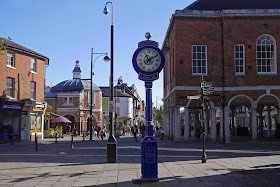The Guildhall
We passed through High Wycombe last Saturday on our way to start the Ridgeway at Ivinghoe Beacon and I realised that I had never really looked at it as a town in its own right, it was just somewhere en route to somewhere else. So today, with good weather in prospect, I decided to have a look around. I parked in the massive Eden Centre shopping complex and largely by lauck managed to park near the exit to the towncentre, emerging rtaher incongrously close to the magnificent Guildhall.
This dates from 1757 and was designed by Henry Keene. It was built on the site of an earlier Guildhall of 1604. Pevsner describes it as "charming".
I had decided to follow Pevsner's "perambulation", aware or course that as it was written in 1960 things could be different. I headed east towards the High St, stopping immediately to admire the Market Hall.
This is also dates originially from the 17th century, but was rebuilt by Robert Adam in 1761 - "not one of his masterpieces" says Pevsner. Maybe, but it is certainly interesting and unusual. The distance signs above the arches indicate that this was once the main road from London to Oxford.
As you continue along the wide and now pedestrianised High St, there is a great view back to the Guildhall as it projects out into the road.
The High St is pleasant enough, but with more modern elements than in Pevsner's day. At the end, I continued into Easton St and enjoyed this ambitious, presumably late Victorian, building. It is one of those that the architect has thrown everything at. The doorway is especially extravagant.
Towards the end of the street is the former Royal Grammar School of 1873. Very picturesque in red and cream brick, it is now an insurance office.
Right in front of it, is what must be Wycombe's oldest building, the "bedraggled remains" (Pevsner - I can't disagree) of St John's Hospital dating back to 1180. This was a classic medieval hospital where a small body of monks or nuns looked after both local people who were poor or sick and wayfarers in need of shelter. Such hospitals are seen as the forerunner of almshouses.
The part that remains is the infirmary hall. There would also have been a chapel and cells for the monks around a courtyard. The hospital was closed during the Dissolution of the Monasteries (I have only recently understood that all monastic buildings were affected, even ones doing such good works as this one) and acquired by the town for use as a school. When this was rebuilt in 1873, most of the original buildings were knocked down. One might ask why?
This was the extent of my eastern walk and I retraced my steps along Easton St to turn left into Queen Victoria Street, where the excellent Edwardian Town Hall of 1903 stood out like a beacon among the drab 1930s buildings that surround it, especially the extremely dull extension.
Pevsner now describes a walk along St Mary's St round to Church St. This has all much changed, but the large church of All Saints is still very much in evidence.
It is medieval in origin, but the fine tower is "a very pretty piece of early Gothic revival" (Pevsner again) of 1755 by Henry Keene (he of the Guildhall). Most of the rest is Victorian restoration.
I carried on into Frogmoor, a rather depressing area showing the economic consequences of the massive Eden Centre: empty buildings and bottom of the market shops.
Finally, returning to the car park, I was delighted to see the Millenium Clock. It is a simplified version of the clocks built all over the country in honour of Queen Victoria's jubilees.
Conditions: sunny.
Distance: two miles.
Rating: four stars. Full of interest. Ideal for a short stroll.









No comments:
Post a Comment